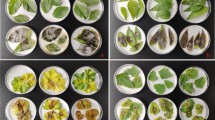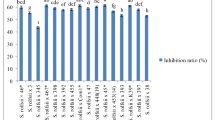Summary
Different isolates ofTrichoderma harzianum andTrichoderma hamatum were isolated from naturally infected roots ofRosellinia necatrix. T. harzianum andT. hamatum isolates overgrew cultures ofR. necatrix placed simultaneously in petri dishes. Relative levels ofR. necatrix population were assessed by the avocado leaf colonization method.T. harzianum isolate T-8, significantly reducedR. necatrix colonization of avocado leaves in comparison to other isolates in artificially and naturally infested soils.R. necatrix inoculum decreased steadily over 4 and 6 week periods in artificially inoculated soil and naturally infested soil respectively when isolate T-8 was applied, to a point where noR. necatrix could be recovered. Disease incidence of almond seedlings was significantly reduced when isolate T-8 was added to naturally infested En-Zurim soil.
Similar content being viewed by others
References
Chet I, Hadar Y, Elad Y, Katan J and Henis Y 1979 Biological control of soilborne plant pathogens byTrichoderma harzianum.In Soil-borne Plant Pathogens. Eds. B Schippers and W Gams, Academic Press, London, New York and San Fransisco, pp 585–591.
Chet I, Harman G E and Baker R 1981Trichoderma hamatum: Its hyphal interactions withRhizoctonia solani andPythium spp. Microb. Ecol. 7, 29–38.
Elad Y, Chet I and Katan J 1980Trichoderma harzianum: A biocontrol agent effective againstSclerotium rolfsii andRhizoctonia solani. Phytopathology 70, 119–121.
Henis Y, Ghaffer A and Baker R 1978 Integrated control ofRhizoctonia solani damping off of radish: Effect of successive plantings, PCNB, andTrichoderma harzianum on pathogen and disease. Phytopathology 68 900–907.
Huang H C 1980 Control of Sclerotinia wilt of sunflower by hyperparasites. Can. Jour. Plant Pathol. 2, 26–32.
Liu S D and Baker R 1980 Mechanism of biological control in soil suppressive toRhizoctonia solani. Phytopathology 70 404–412.
Locke J C, Marois J J and Papavisas G C 1982 Biological control of Fusarium wilt of greenhouse grown chrysanthemums. Phytopathology 72, 709 (Abstr.).
Rifai M A 1969 A revision of the genus Trichoderma. Commonw. Mycol. Inst., Mycol. Papers 116, 56 pp.
Sivan A, Elad Y and Chet. I 1983 Biological control effects of a new isolate ofTrichoderma harzianum onPythium aphanidermatum. Phytopathology 74, 498–501.
Sztejnberg A and Madar Z 1980 Host range ofDematophora necatrix, the cause of white root rot disease in fruit trees. Plant disease 64, 662–664.
Sztejnberg A, Omary N and Pinkas Y 1983 Dematophora root rot on avocado trees in Israel and development of a diagnostic method. Phytoparasitica 11, 238–239 (Abstr.).
Author information
Authors and Affiliations
Rights and permissions
About this article
Cite this article
Freeman, S., Sztejnberg, A. & Chet, I. Evaluation ofTrichoderma as a biocontrol agent forRosellinia necatrix . Plant Soil 94, 163–170 (1986). https://doi.org/10.1007/BF02374340
Received:
Accepted:
Issue Date:
DOI: https://doi.org/10.1007/BF02374340




